
Case Report
Austin Oncol.2016; 1(3): 1012.
Pelvic High Grade Chondrosarcoma Delayed Development: Can Bisphosphonates be Responsible? A Case Report
Raimondo P¹, Tiziana R², Alessandra L³, Pietro P¹, Giovanni G4, Alessandro C5 and Boffano M¹
¹Department of Oncologic and Reconstructive Orthopaedic, AOU Città della Salute e della Scienza CTO Hospital Torino, Via Zuretti, Italy
²Department of Radiology, AOU Città della Salute e della Scienza CTO Hospital Torino, Via Zuretti, Italy
³Department of Pathology, AOU Città della Salute e della Scienza - OIRM-S.Anna Hospital Torino, Italy
4Department of Oncology, IRCCS Candiolo, Italy
5Department of Oncology, Gradenigo Hospital, Italy
*Corresponding author: Michele Boffano, Dept Oncologic and Reconstructive Orthopaedic- AOU Città della Salute e della Scienza di Torino – Via Zuretti, Torino, Italy
Received: September 11, 2016; Accepted: November 08, 2016; Published: November 09, 2016
Abstract
High grade Chondrosarcoma (CS) is a surgical disease despite its aggressive behaviour of recurring locally and spreading to the lungs; at Imaging, amorphous snowflake calcification in the lytic area and extraosseous calcified mass are characteristic. Conventional chemo-radiotherapy is ineffective. Some preliminary in vitro studies showed that Nitrogen-containing BisPhosphonates (N-BPs) may play a role in the treatment of CS. We report on a 83-year-old man patient diagnosed in June 2012 with high grade CS of the left pelvis. At Imaging abundant reactive sclerosing bone with small well delimitated lytic areas, not typical of high grade CS, and the typical large calcified mass spreading into the pelvis were present. In the last 10 years he was treated with N-BPs weekly for fragility vertebral fractures. X-rays of the pelvis were periodically performed: in 1990 in the left pubic ramus two small spot calcifications were evident; in 2002 a sclerotic and lytic lesion of the left pubic ramus was present, hyper camp tant at whole body bone scintigraphy; in 2003 the pubic lesion was more lytic, and extended to acetabulum. In absence of symptoms, no other imaging was performed until 2012. We hypothesise that N-BPs influenced in vivo the development of the sarcoma, at imaging present at least from 2002, inhibiting the bone resorption, inducing bone sclerosing and controlling pain for many years. This case suggest that N-BPS may play a role in vivo in controlling the development of CS and pain. Further research is needed.
Keywords: Chondrosarcoma; BisPhosphonates; X-rays
Introduction
Chondrosarcoma (CS) is the second most frequent malignant bone tumour in adults; it is characterised by the production of malignant cartilaginous tissues with lobular type architecture. The conventional intramedullary or central CS is the most frequent type, and it most commonly involves the long bones or pelvis in up to 65% of cases [1]. Hyaline cartilage nodules have a high water content and peripheral enchondral ossification. At Imaging, CS appears translucent at X-rays, hypodense at Computed Tomography (CT) scan, hypointense at T1 sequences and hyperintense at T2 weighted and fat suppressed Magnetic Resonance (MR) sequences: the typical lobular endosteal scalloping and the distinctive ring-andarc calcification with progressive cortical destruction and extension in contiguous soft tissue are evident. The cortex responds leading to cortical remodelling and thickening, less frequently periosteal reaction, but not to a diffuse reactive bone sclerosis [2,3]. Although high grade CS is considered to be at high risk for metastases, usually CS is treated by en bloc surgical resection with wide margins because it does not respond to conventional chemotherapy or to radiotherapy. Surgical adequate margins are difficult to be obtained when CS develops in the pelvic girdle because often the CS has a large size and connections with articular, nervous, vascular and visceral structures; disability is often the final result [4]. Nitrogen-containing BisPhosphonates (N-BPs) are currently approved for the treatment of bone metastases independently of the primary tumour type: they are able to change the bone and tumour microenvironment, delaying (or reducing) the ability of malignancy to emerge [5,6]. Some preliminary studies in vitro and in vivo suggest that N-BPs might be able to inhibit growth of primary bone tumours [7-10] in particular CS [11-13] and to decrease pain in vivo [14]. We report on a 83-yearold male patient diagnosed in June 2012 with high grade CS of the left pelvis: at Imaging, abundant reactive sclerosing bone with small well delimitated lytic areas, not typical of high grade CS, and the typical large calcified mass spreading into the pelvis, were present. He was treated for 10 years with N-BPs weekly for fragility vertebral fractures and primary hyperparathyroidism. We hypothesise that N-BPs influenced in vivo the development of the sarcoma, at imaging present at least from 2002, inhibiting the bone resorption, inducing bone sclerosing and controlling pain for many years, allowing a high quality of life until the last 3 months.
Care Presentation
In June 2012 an 83-year-old Caucasian male, with persisting pain at the left side of the groin and thigh from 3 months, was sent for diagnosis and staging to a Regional Referral Centre for Bone and Soft Tissue Sarcomas. X-Rays (Figure 1a) and CT scan (Figure 1b,1c) showed, in the left pubic ramus, acetabulum and iliac bone (area 1, 2 and 3 according to Musculoskeletal Tumour Society) abundant reactive bone and limited cortical mottled destruction, well delimited by sclerotic bone; and a large mass with arc-and-ring calcifications arising from the pubic ramus protruding into the pelvis. MRI (Figure 1d,1e,1f,1g) demonstrated a typical lobular lesion extending into contiguous soft tissue. After a contrast-enhanced Ultrasound (CEUS) study, a core needle biopsy focused on the more anarchic vascularised area, as a potential source of a representative pathological tissue (Figure 1h) [15]. Histology demonstrated chondrosarcoma GIII; at general staging, absence of metastatic lesions. The patient refused any surgical treatment and a palliative therapy was started. At history, the patient referred recurrent chronic aspecific lower back pain irradiating to the left leg. In 1990 (the patient was 61 years old) an X-ray of the pelvis demonstrated two small spot calcifications in the left pubic bone (Figure 2). In July 2002 (72 years old) an X-ray showed a limited irregular sclerotic and lytic lesion in the left pubis and acetabulum, with endosteal scalloping and a lobular pattern of translucency (Figure 3); the lesion was hypercaptant at whole body bone scintigraphy. Diagnosis of primary hyperparathyroidism (pHPT), Monoclonal Gammopathy of Undetermined Significance (MGUS) and fragility fracture of L4 and L5 was advanced; after evaluation of osteoporosis by posteroanterior lumbar and bilateral hip Dual Energy X-Ray Absorptiometry (DXA), therapy with alendronate 10mg/die (replaced in 2007 with risedronate 75 mg/ a week), Calcium and Vitamin D3 was started; periodical clinical and blood controls were performed in the following years. In 2003, epidural corticosteroids injection for lumbar discal protrusion in narrow canal solved an acute pain; at X-ray the endosteal scalloping at pubic ramus was more evident, while the lesion appeared more sclerotic in the acetabulum (Figure 4); in absence of symptoms, no further Imaging was performed. From March 2012 pain at the left side of the groin and anterior thigh occurred; in May 2012 risedronate was confirmed and, due to worsening of left hip pain, Imaging, reported at the beginning of the history, was performed.
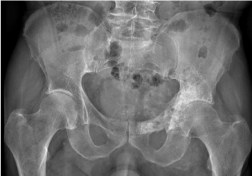
Figure 1a: High grade chondrosarcoma of the left pelvis (2012). X-ray
antero-posterior view: sclerosis is preeminent with small translucent areas
in pubic ramus and whole acetabulum. The cortex is destroyed. A soft tissue
mass is protruding into the pelvis and obturator areas with typical arc-and-ring
calcifications.
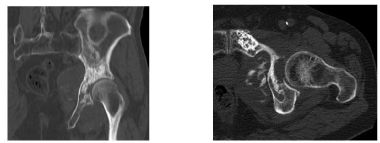
Figure 1 b, c: CT coronal and c axial views: the bone sclerosis is preeminent,
particularly at the pubic ramus and at the acetabular roof; the large pelvic soft
tissue mass shows typical arc-and-ring calcifications.
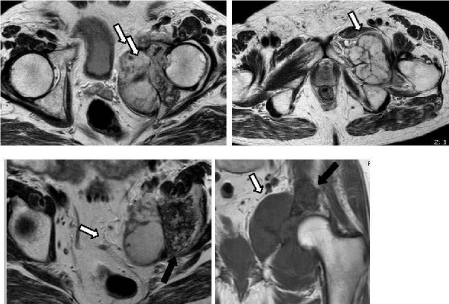
Figure 1 d, e, f, g: At axial T2 weighted sequence and g at coronal T1
weighted sequence in the extra skeletal component (white arrows) of the
chondrosarcoma the typical lobulated pattern with chondral matrix rich in
water and arc-and-ring calcifications is evident. Conversely in the ileum (black
arrows) unusual reactive sclerosis of the bone is preeminent and markedly
hypointense in both sequences.
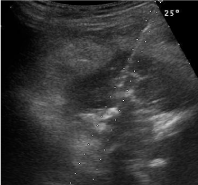
Figure 1h: Core needle US-guided biopsy focused in the area of anarchic
vascularisation at CEUS.
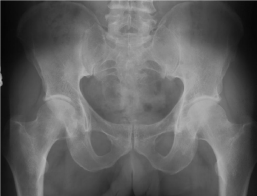
Figure 2: X-ray antero-posterior view: in 1990 two punctated calcifications
were evident in the left pubic ramus without any osteolysis or endosteal
scalloping.

Figure 3: X-ray antero-posterior view: in 2002 osteolysis with endosteal
scalloping in the left pubic ramus, and cortical bulging and sclerosis of
acetabulum were evident.

Figure 4: X-ray antero-posterior view; in 2003 sclerosis is more evident,
particularly at the acetabular roof.
Discussion
Usually, high grade CS in the pelvis is extra compartmental: X-ray and CT scans show largely calcified extraosseous masses protruding from underlying areas of cortical and spongy bone destruction. The bone cortex appears destroyed from within; reactive bone is minimal to absent with vaguely defined edges, according to the aggressiveness of the lesion [1-3]. MRI is typical with hypointensity at T1 sequences and hyperintensity at T2 weighted and fat suppressed MR sequences. In this reported case, whereas the large extraosseous mass protruded into the pelvis was typical of high grade CS, bone radiological characteristics were quite different from the usual: reactive bone was the prominent aspect of pelvic bone, with numerous dense irregular sclerotic trabeculae instead of cartilage lobules, particularly at the acetabular roof. The edge between the soft tissue portion of the tumour and the bone was well marked by reactive bone and only mottled cortical destruction was present, always well delimited. Furthermore, the 83-year-old patient had a high quality of life until 3 months before the diagnosis, when moderate to severe pain at the left leg required pharmacological therapy. At history, due to recurrent aspecific low back pain irradiated to the left leg, the patient performed at least three X-rays of the pelvis, in 1990, in 2002 and in 2003. From 2002 and for 10 years, the patient was treated with N-BPs for fragility lumbar vertebral fractures and pHPT. N-BPs are chemical compounds with a P-C-P structure with affinity for bone hydroxyapatite crystals and have been used for many years to reduce bone osteoclastic resorption both in benign and malignant diseases [5]. They are able to change the permissive microenvironment required for frank malignancy to emerge [6]. Malignant bone tumour development is related to the induction of bone resorption by osteoclast activation. Bone resorption contributes to tumour growth into bone by the release of cytokines (IL6, TNFalfa) and other complex microenvironment changes. BPs have anti-osteoclast functions and indirect anti-tumour effects: they interfere with bone microenvironment and target endothelial and immune cells (tumour-associated macrophages, gamma9 delta 2 T cells) and osteoclasts [7-10]. In vitro BPs induce chondrosarcoma cell death [7,11-13]; in vivo only one case report on metastatic CS treated with N-BP was reported [14]. We cannot demonstrate if in this case an enchondroma was previously present (see X-ray in 1990), and if CS developed in 2002-2003 (only X-rays were done), and if and for how many years N-BPs were responsible for pain control, bone remodelling and, possibly, inhibition of CS growth. In fact, CS of the pelvis can remain asymptomatic for long periods, allowing the development of large tumoral masses [1]; furthermore, it is possible that, whereas a bioptical sample demonstrated a GIII CS, in other areas a dedifferentiated CS could be present, characterised sometimes by more sclerotic areas than usually, but the core needle biopsy performed after CEUS study has high sensitivity and specificity [15] and sequential imaging of this case is quite suggestive. Furthermore, if we consider the topographical characteristics of this case, we can hypothesise that at the beginning (in 2002-2003) the CS was low grade and limited to the left pubic area and acetabulum (zone 3 and 2), where surgical en bloc excision with adequate margins and reconstruction, and consequently acceptable disability and low risk for recurrence and metastases, would had been the golden standard therapy. Now, in June 2012, the high grade tumour is involving all three areas of the pelvic bone and a large mass is invading the pelvis; surgery is highly demanding (hindquarter amputation or limb salvage with resection of the three areas with or without reconstruction), with a high risk of perioperative complications and residual disability. However, the 83-year-old patient had a high (good) quality of life until 3 months before the diagnosis: we wonder if standard surgical resection in 2002-2003 could have given him similar results.
Conclusion
The case reported above showed that the high grade CS of the pelvis was characterised by usual large calcified mass protruding into the pelvis, but unusual abundant reactive bone with small lytic lesions, well limited by sclerotic bone. The 83-year-old patient, before sarcoma diagnosis, was treated for 10 years for vertebral osteoporotic fractures and pHPT with N-BPs. This case may suggest that N-BPS may play a role in vivo in controlling the development of CS and pain. Further research is needed but, especially when surgery is highly demanding with disabling results such as in primary CS of the pelvis in an older patient, N-BPs therapy could be considered as a palliative therapy able to delay symptoms, allowing a good quality of life, in particular when the patient refuses surgery or when the limb cannot be saved. Further studies, both in vitro and in vivo, are mandatory.
References
- Campanacci M. Central Chondrosarcoma. In: Bone and Soft Tissue Tumors. Wien New York: Springer-Verlag. 1999; 267-304.
- Murphey MD, Walker EA, Wilson AJ, Kransdorf MMJ, Temple HT, Gannon FH. Imaging of Primary Chondrosarcoma: Radiologic-Pathologic Correlation. RadioGraphics. 2003; 23: 1245-1278.
- Ollivier L, Vanel D, Leclere J. Imaging of chondrosarcomas. Cancer Imaging. 2003; 4: 36-38.
- Deloin X, Dumaine V, Biau D, Karoubi M, Babinet A, Tomeno B, et al. Pelvic chondrosarcomas: surgical treatment options. Orthopaedics and Traumatology: surgery and research. 2009; 95: 393-401.
- Lipton A. Treatment of bone metastases and bone pain with biphosphonates. Support Cancer Ther. 2007; 9: 92-100.
- Valastyan S, Weinberg RA. Tumour metastasis: molecular insight and evolving paradigms. Cell. 2011; 147: 275-292.
- Moriceau G, Ory B, Gobin B, Verrecchia F, Gouin F, Blanchard F, et al. Therapeutic approach of primary bone tumours by biphosphonates. Current Pharmaceutical Design. 2010; 16: 2981-2987.
- Cheng Y, Huang L, Kumta S, Lee KM, Lai FM, Tam JSK. Cytochemical and ultrastructural changes in the osteoclast-like giant cells of giant cell tumour of bone following biphosphonate administration. Ultrastruct Pathol. 2003; 27: 385-391.
- Chang SS, Suratwala SSJ, Jung KM. Biphosphonates may reduce recurrence in giant cell tumour by inducing apoptosis. Clin Orthop Relat Res. 2004; 426: 103-109.
- Hirbe AC, Roelofs AJ, Floyd DH. The biphosphonate zoledronic acid decreases tumour growth in bone in mice with defective osteoclasts. Bone. 2009; 44: 908-916.
- Lai T, Hsu S, Li T, Hsu H, Lin J, Hsu C et al. Alendronate inhibits cell invasion and MMP-2 secretion in human chondrosarcoma cell line. Acta Pharmacol Sin. 2007; 28: 1231-1235.
- Susa M, Morii T, Yabe H, Horiuchi K, Toyama Y, Weissbach L, et al. Alendronate inhibits growth of high grade chondrosarcoma. Anticancer Res. 2009; 29: 1879-1888.
- Streitbuerger A, Henrichs M, Ahrens H, Lanvers-Kaminsky C, Gouin F, Gosheger G, et al. Cytotoxic effect of clodronate and zoledronate on the chondrosarcoma cell lines HTB-94 and CAL-78. Int Orthop 2011; 35: 1369- 1373.
- Montella L, Addeo R, Faiola V, Cennamo G, Guarrasi R, Capasso E, et al. Zoledronic acid in metastatic chondrosarcoma and advanced sacrum chordoma: two case reports. J Experimental and Clinical Cancer Research. 2009; 28: 7.
- De Marchi A, Brach del Prever EM, Linari A, Pozza S, Verga L, Albertini U, et al. Accuracy of core-needle biopsy after contrast-enhanced ultrasound in soft-tissue tumours. Eur Radiol. 2010; 20: 2740-2748.